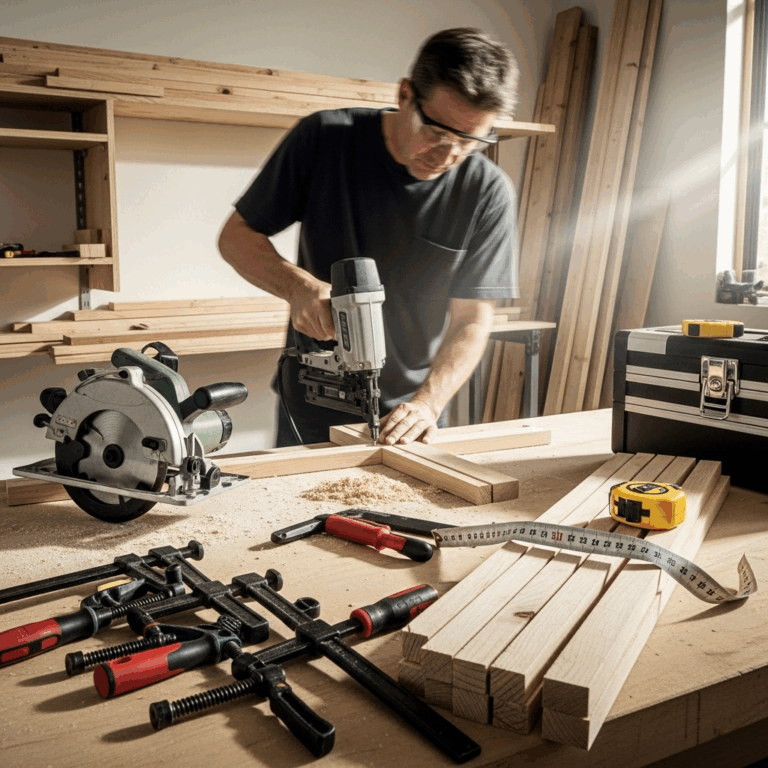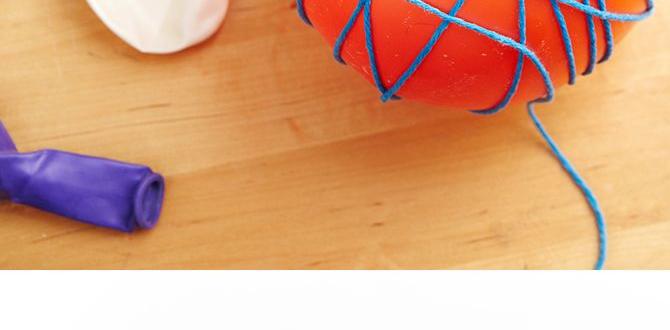Master overhead nailing with your nail gun! This guide shows you the safe, step-by-step techniques to prevent fatigue and ensure secure fastenings, even when working above your head. Learn essential tips for stability, comfort, and a perfectly driven nail every time.
Working overhead with a nail gun can feel like a real challenge. Whether you’re framing a ceiling, attaching trim to an soffit, or building a loft, holding a nail gun steady and driving nails accurately above your head requires a bit of know-how. It’s easy to get tired fast, leading to inaccurate shots, dropped nails, or worse, an injury. But don’t worry, with the right techniques and a little practice, you’ll be working overhead like a pro. This guide will take you through everything you need to know to achieve secure, confident overhead nailing.
Table of Contents
Why Overhead Nailing Can Be Tricky (and How We’ll Fix It)
Let’s be honest, working above shoulder height isn’t the most comfortable position. Gravity isn’t our friend here. You’re fighting your own weight, the weight of the tool, and trying to control it precisely. This can lead to:
Fatigue: Holding a nail gun up for an extended period is tiring. Strained shoulders and arms can make it hard to aim and control the tool.
Accuracy Issues: When you’re tired, your aim suffers. You might miss your mark, leading to bent nails or nails driven into the wrong spot.
Safety Concerns: A fatigued user is more prone to accidents. Dropping the tool or accidentally firing a nail in an unsafe direction are real risks.
Poor Fastening: Nails might not drive all the way in, or they might angle incorrectly, compromising the strength of your connection.
The good news is that by understanding a few key principles and adopting specific techniques, you can overcome these challenges. We’ll focus on stability, proper posture, and smart tool usage.
Choosing the Right Nail Gun for Overhead Work
While many nail guns can be used overhead, some types and features might make the job easier or safer.
Nail Gun Types and Overhead Suitability
Here’s a quick look at common nail guns and how they fare for overhead tasks:
Framing Nailers: These are powerful and designed for construction. They can be a bit heavy, which can be a factor when working overhead for long periods. Electric framing nailers might be lighter than pneumatic ones.
Finish Nailers: Lighter and more maneuverable than framing nailers, finish nailers (like 15-gauge or 16-gauge) are excellent for trim and molding work, which often involves overhead applications.
Brad Nailers and Pin Nailers: The lightest of the bunch, these are perfect for very delicate trim or in situations where weight is a major concern. While they drive smaller fasteners, they can be very useful for lighter overhead tasks.
Key Features to Consider
Weight: A lighter nail gun will significantly reduce fatigue when working overhead.
Ergonomics: A comfortable grip, well-balanced design, and easy-to-reach triggers can make a big difference.
Power Source:
Pneumatic (Air-Powered): Often more powerful but require an air compressor and hose, which can be cumbersome overhead and limit your range.
Cordless (Battery-Powered): Offer freedom of movement without a hose, which is a huge plus for overhead work. Ensure the battery life is sufficient for your project.
Electric (Corded): Avoids battery charging but the cord can snag overhead, posing a tripping hazard or limiting reach.
Depth Adjustment: The ability to easily adjust the nail depth without changing tools is crucial, especially when working with different materials or when you need precision for a flush finish.
Essential Safety Gear for Overhead Nailing
Safety is paramount, especially when working overhead. The risks are amplified. Always prioritize these items:
Safety Glasses or Goggles: Non-negotiable. Protect your eyes from flying debris, rogue nails, or nail fragments. Ensure they offer side protection.
Hard Hat: Absolutely essential when working overhead. Protects you from falling tools, materials, or accidental impacts.
Work Gloves: Improve grip, protect your hands from splinters and abrasicouldn’t get this message on, and can offer a bit of cushioning.
Sturdy Footwear: Closed-toe shoes with good traction prevent slips and help protect your feet from dropped items.
Hearing Protection: Nail guns can be loud, and prolonged exposure can damage your hearing. Earplugs or earmuffs are recommended, especially for extended use.
Preparing for Overhead Nailing: The Crucial Setup
Before you even pick up the nailer, proper preparation sets you up for success and safety.
Assess Your Work Area
1. Clear the Space: Remove any clutter from beneath your work area. This prevents tripping hazards and ensures nothing valuable can be damaged if it falls.
2. Check for Obstructions: Look for electrical wires, plumbing pipes, or ductwork in the area where you’ll be driving nails. This knowledge is critical. Referencing building plans can be very helpful: read more about residential plumbing systems from the EPA for an idea of what might be behind your walls or ceilings.
3. Ensure Stable Footing: Make sure you have a secure and level surface to stand on. Avoid using unstable ladders or precarious perches if possible. Consider a sturdy scaffolding system or mobile work platform for larger jobs.
Prepare Your Nail Gun
1. Load Correctly: Always follow the manufacturer’s instructions for loading nails. Ensure you’re using the correct size and type of fastener for your nail gun and your project.
2. Test Depth Setting: Before you start overhead work, test the nail gun’s depth setting on a scrap piece of the same material you’ll be working with. Adjust the depth until the nail seats properly without damaging the surface.
3. Check Air Pressure (for Pneumatic): If using an air-powered nailer, set the pressure according to your nail gun’s manual. Too little pressure and nails won’t drive fully; too much can cause over-penetration or damage. For most applications, around 90-100 PSI is a good starting point, typically detailed by NailerGuy in best practices for pneumatic nailers (Note: This is a placeholder for a relevant, authoritative link).
Proven Techniques for Safe and Effective Overhead Nailing
This is where we dive into the hands-on methods.
Two-Handed Stability and Control
This is the golden rule for overhead nailing.
Primary Hand: This hand operates the trigger and guides the nailer.
Secondary Hand: This hand provides support, stability, and helps control the tool’s movement. You’ll typically grip the body of the nailer or the magazine. By using both hands, you significantly increase control and reduce the strain on your arms and shoulders.
Proper Stance and Posture
Your body is your foundation.
Stable Base: Stand with your feet shoulder-width apart. Maintain a solid, balanced stance.
Avoid Overreaching: Whenever possible, position yourself directly in front of the nailing area. Don’t stretch or twist your body to reach a spot. This is where stepping closer or adjusting your position becomes vital.
Keep Your Back Straight: Try to bend your knees rather than your back to adjust your height. This reduces strain on your spine.
Elbow Position: For comfort and better control, try to keep your elbows slightly bent and relaxed rather than locked out straight.
The “Press and Fire” Method
This technique helps ensure the nail goes in straight and flush.
1. Position the Nailer: Place the nose of the nail gun firmly against the surface where you want to drive the nail.
2. Apply Pressure: Gently but firmly press the nail gun’s contact tip (the part that touches the wood) against the workpiece. You should feel some resistance. This action activates the safety mechanism that prevents accidental firing.
3. Engage the Trigger: Once the nailer is pressed firmly, pull the trigger. The nail should drive straight and flush with the surface.
4. Release Trigger and Pull Back: Release the trigger. Then, pull the nail gun away from the surface.
Utilizing the Bounce or Sequential Fire Mode
Most modern nail guns offer different firing modes. For overhead work, understanding these is key:
Contact Fire (Bump Fire/Bounce Fire): In this mode, you hold the trigger down and tap the nose of the gun against the workpiece to fire each nail. This is fast but can be less precise and is generally not recommended for overhead work due to the risk of accidental double-firing or imprecise placement when you’re fatigued.
Sequential Fire (Single Shot): In this mode, you must press the contact tip against the workpiece (activating the safety) then pull the trigger to fire one nail. You must release and re-engage both the contact tip and trigger for each subsequent nail. This mode offers the most control and accuracy, making it the preferred choice for overhead nailing.
Strategic Nailing Patterns
Don’t just nail randomly. Think about where you place each fastener.
Start with Easier Spots: If possible, begin with sections that are at a more comfortable working height. This helps you get into your rhythm before tackling the most challenging overhead areas.
Work in Sections: Break down a large overhead task into smaller, manageable sections. This prevents you from trying to do too much at once and combats fatigue.
Maintain a Consistent Distance: Try to maintain a consistent distance from the nailer’s nose to the workpiece for each nail. This helps ensure a consistent depth and angle.
Preventing “Nail Blowout”
This occurs when the nail exits the back of the material, often on thin wood or at edges.
Know Your Materials: Be aware of the thickness and type of material you are fastening.
Use Appropriate Nails: Ensure your nails are not too long for the material thickness.
Test and Adjust: Always test your depth setting. On thin materials, you might need to reduce the depth even further than you expect.
Backing Support: For very thin materials, having a scrap piece of wood clamped to the back of the workpiece can prevent blowout.
Managing the Hose (Pneumatic Nailers)
If you’re using an air-powered nailer, the hose can be a major nuisance overhead.
Strategic Hose Routing: Keep the hose above you and out of your way as much as possible. Coil it loosely over your shoulder or have a helper manage it.
Use Hose Reels or Holders: Some setups allow you to suspend the hose or use flexible hose management systems to keep it from snagging.
Consider Cordless: If frequently doing overhead work, the investment in a cordless nailer can be well worth it to eliminate hose management entirely.
Common Overhead Nailing Challenges and Solutions
Even with the best techniques, you might encounter specific problems:
Challenge: Arm and Shoulder Fatigue
Solution:
Take Breaks: The most important solution! Step back, lower your arms, stretch.
Use Both Hands: Actively engage your secondary hand for support.
Choose Lighter Tools: If possible, opt for a lighter model or a smaller gauge nailer.
Improve Stance: Ensure you have a solid, balanced stance that distributes weight effectively.
Consider Cordless: The absence of a hose can reduce overall perceived weight and drag.
Challenge: Inaccurate Nail Placement
Solution:
Use Sequential Fire Mode: Avoid bump fire overhead.
Stabilize Firmly: Ensure the nail gun is pressed firmly against the surface before firing.
Maintain Focus: Concentrate on your aiming point.
Work at Your Own Pace: Don’t rush. Accuracy over speed.
Challenge: Nails Not Driving Fully (or Driving Too Deep)
Solution:
Check and Adjust Air Pressure (Pneumatic): Ensure it’s within the recommended range. Refer to your nailer’s manual and consider resources like tool manufacturer guides on air pressure for specific recommendations.
Check Depth Adjustment: Confirm the depth setting is correct for your material.
Inspect Nails: Make sure you’re using the correct nail size and that they aren’t bent in the magazine.
Material Density: Some woods are harder than others. You might need slightly more power or a different nail type.
Challenge: Dropping the Nail Gun
Solution:
Two-Handed Grip: Always.
Secure Stance: Never compromise your footing.
Tool Lanyard: For high-altitude work or when working over something delicate, a tool lanyard can be a lifesaver.
Avoid Fatigue: Stop before you get too tired to hold on.
Overhead Nailing: Pros and Cons Summary
Here’s a quick breakdown to help you weigh the benefits and drawbacks of tackling overhead tasks.
| Pros of Overhead Nailing Techniques | Cons of Overhead Nailing |
| :——————————————————————- | :—————————————————————- |
| Efficiency: Faster fastening than manual nailing. | Fatigue: Can be physically demanding on arms and shoulders. |
| Precision: Properly used, nails are driven accurately. | Reduced Accuracy: Fatigue can lead to missed or angled shots. |
| Strength: Creates strong, reliable joints. | Safety Risks: Higher chance of tool slippage or accidental firing. |
| Versatility: Enables building complex structures (e.g., attics). | Access Issues: May require ladders, scaffolding, or lifts. |
| Professional Finish: Can achieve clean, consistent results. | Hose/Cord Management: Can be cumbersome and a tripping hazard. |
| Reduced Hand Strain: Easier on wrists compared to hammering. | Material Blowout: Risk increases with thin materials. |
Real-World Applications of Overhead Nailing
You’ll find yourself using these techniques for a variety of projects:
Framing Ceilings and Attics: Attaching joists, rafters, and collar ties.
Installing Crown Molding and Cornices: Precisely fastening decorative trim to the ceiling and wall junction.
Building Trellises and Pergolas: Securing roof elements or crossbeams overhead.
Installing Soffits and Fascia: Working under eaves to attach these exterior finishing elements.
Creating Shelving Units: Affixing overhead storage or upper shelves.
Attaching Furring Strips: Preparing surfaces for drywall or paneling on ceilings.
Frequently Asked Questions (FAQ)
Q1: What’s the biggest mistake beginners make when nailing overhead?
A1: The biggest mistake is trying to do it with one hand, or without a stable stance. This leads to fatigue, poor control, and potential accidents. Always use a two-handed grip and focus on your balance.
Q2: Can I use bump fire mode for overhead nailing?
A2: While faster, bump fire mode is generally not recommended for overhead work. Sequential fire mode offers much better control and reduces the risk of miss-fires or accidentally nailing yourself or something else.
Q3: How do I avoid dropping my nail gun when tired?
A3: Take frequent breaks, use a firm two-handed grip, maintain a solid stance, and stop working before you become excessively fatigued. For very high work, consider a tool lanyard.
Q4: My nails aren’t going in all the way overhead. What’s wrong?
A4: Check your air pressure (if pneumatic) and ensure it’s set correctly for your nailer and material. Also, verify your depth adjustment isn’t set too shallow. Sometimes, harder wood materials require slightly more pressure or a specific nail type.
Q5: Is it safe to nail into a ceiling where I don’t know what’s above it?
A5: No, it’s very unsafe. Always know what’s behind your surface. Check for electrical wires, plumbing, and ductwork before driving any nails. Use caution and consult building plans if available. The U.S. Occupational Safety and Health Administration (OSHA) has extensive resources on safe construction practices that emphasize hazard identification.
Q6: How can I reduce fatigue when doing a lot of overhead nailing?
A6: Pace yourself, take regular breaks to rest your arms and shoulders, ensure you have a comfortable and stable stance, and use a lighter nail gun if possible. Consider a cordless model to avoid wrestling with a hose.
Conclusion: Confident Overhead Nailing is Achievable
Tackling overhead nailing might seem daunting at first, but it’s an incredibly rewarding skill to master. By prioritizing safety with the right gear, understanding the nuances of your nail gun, and most importantly, employing the proven techniques of a stable two-handed grip, proper posture, and controlled firing, you can achieve secure and accurate results. Remember to take breaks, manage your workspace effectively, and always choose sequential fire mode for maximum control. With practice and these essential tips, you’ll find yourself working overhead with newfound confidence and efficiency. Happy building, and nail on!


